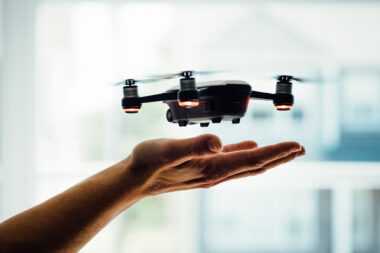Introduction
In the realm of construction and infrastructure, the advent of smart sensors has revolutionized how structures are monitored, maintained, and analyzed. These sensors offer real time data, facilitating early detection of potential issues, enhancing safety, and extending the lifespan of infrastructure assets.
Types of Sensors Used in Infrastructure Monitoring
- Strain gauges measure the strain in a structure, indicating potential stress and strain changes that could compromise structural integrity.
- Accelerometers: Used to detect and measure vibrations and movements within structures, essential for earthquake prone areas.
- Displacement Sensors: Measure movement and displacement to detect shifts that could indicate stability issues.
- Corrosion Sensors: Monitor the rate of corrosion in metal components, critical for maintaining the health of bridges and other metallic structures.
- Fiber Optic Sensors: Utilize light to measure various parameters like temperature, strain, and pressure with high accuracy and over large distances.
- Piezoelectric sensors generate voltage in response to mechanical stress and are used for vibration, acceleration, and pressure measurements.
The Working Process of Smart Sensors
1. Data Acquisition
This is the first and fundamental step in the working process of smart sensors. These sensors are strategically placed on various parts of a structure (such as bridges, buildings, tunnels, and dams) to measure specific parameters like temperature, strain, displacement, vibration, and humidity. Depending on the type of sensor, data acquisition involves the direct measurement of physical conditions or changes in the environment or structure.
- Strain gauges capture the deformation or strain in structural elements, converting mechanical movement into an electrical signal.
- Accelerometers measure the acceleration forces (dynamic and static) that structures are subjected to, providing data on vibrations and potential structural weaknesses.
- Fiber optic sensors, through changes in light signals, measure various parameters, including temperature fluctuations and strain, offering high sensitivity and spatial resolution.
2. Signal Processing
After the acquisition of raw data, signal processing is crucial. This step involves converting the raw data from the sensors into a format that can be analyzed. Smart sensors typically have built in microprocessors for initial data processing, which includes filtering noise, amplifying signals, and converting analog signals to digital data. This processed data provides accurate and meaningful insights into the condition of the infrastructure.
3. Data Transmission
Once the data is processed, it needs to be transmitted to a central system for further analysis. This transmission can occur over wired connections or, more commonly, through wireless networks. The use of wireless sensor networks (WSNs) and the Internet of Things (IoT) technology facilitates seamless and real time data transmission. These technologies enable the integration of sensors into a networked system, allowing them to communicate with each other and with central monitoring stations.
- Wireless Sensor Networks (WSN) are particularly advantageous in construction monitoring due to their flexibility, scalability, and the ability to cover large areas without the need for extensive wiring.
- IoT platforms collect data from various sensors and devices, making it accessible through the internet for monitoring and analysis from remote locations.
4. Analysis and Decision Making
The transmitted data is stored and analyzed using advanced software tools that can identify patterns, anomalies, and trends. Artificial intelligence (AI) and machine learning (ML) algorithms are increasingly used to automate the analysis, improving the ability to predict potential failures or maintenance needs before they pose a significant risk.
- Predictive Maintenance: By analyzing data trends, predictive models can forecast potential points of failure, allowing for maintenance before a fault occurs.
- Structural Health Monitoring (SHM): Continuous data analysis helps in assessing the overall health of a structure, identifying areas that may require attention or intervention.
5. Feedback and Action
The final step in the process involves taking action based on the insights gained from the data analysis. This could involve:
- Sending alerts to engineers and maintenance teams about potential issues.
- Automating control systems to adjust environmental conditions or load distribution in response to sensor data.
- Implementing preventive maintenance will address identified risks, thereby extending the lifespan of the structure and preventing costly repairs or failures.
The integration of smart sensors into construction and infrastructure projects represents a significant advancement in ensuring the longevity, safety, and efficiency of these structures. Through continuous monitoring, data analysis, and timely intervention, smart sensors play a crucial role in the modern approach to construction and infrastructure management.
Manufacturing and technology
The manufacturing and technology behind smart sensors involve sophisticated processes, advanced materials, and the integration of cutting edge electronics. These sensors are pivotal for various applications, including infrastructure monitoring, where precision, reliability, and durability are crucial.
1. Microfabrication and nanotechnology
- Microfabrication: This is a process used to create small structures on the micron scale, similar to those used in semiconductor manufacturing. It involves techniques like photolithography, etching, and deposition to build sensor components layer by layer. This process is crucial for creating the intricate designs of sensor elements, especially for MEMS (Micro Electro Mechanical Systems) sensors like accelerometers and pressure sensors.
- Nanotechnology involves manipulating materials on an atomic or molecular scale, which is used to enhance the sensitivity and performance of sensors. For example, using nanomaterials like carbon nanotubes or graphene can significantly increase the electrical conductivity and surface area of sensor elements, leading to higher sensitivity and faster response times.
2. Advanced Material Usage
Smart sensors utilize a variety of materials, each selected for its specific properties:
- Polymers are used for flexibility and durability, especially in sensors that need to be applied to surfaces that may experience strain or movement.
- Ceramics offer excellent thermal and chemical stability, making them ideal for temperature and gas sensors.
- Composites and metals are used for their strength, conductivity, and resistance to environmental factors, which are essential for long term deployment in infrastructure.
3. Integration of Electronics
The integration of microcontrollers, signal processing units, and communication modules is crucial for the’smart’ capabilities of these sensors. This process involves:
- Printed Circuit Board (PCB) Assembly: Components like microprocessors, wireless modules, and power management circuits are mounted on PCBs.
- System on Chip (SoC) solutions incorporate multiple electronic components into a single chip, reducing size and power consumption while increasing reliability and performance.
- Energy Harvesting Technologies: Some smart sensors incorporate mechanisms to harvest energy from their environment (e.g., solar, vibration) to power themselves, reducing or eliminating the need for external power sources.
Technology
1. Micro Electro Mechanical Systems (MEMS)
MEMS technology is foundational to many smart sensors, integrating mechanical and electrical components that can range from a few micrometers to a millimeter in size. MEMS sensors include accelerometers, pressure sensors, and gyroscopes, which are critical for monitoring structural health, vibrations, and movements in infrastructure. The precision and miniaturization afforded by MEMS technology allow these sensors to be embedded within structures without affecting their integrity or performance.
2. Wireless Communication Technologies
Smart sensors rely on various wireless technologies to transmit data effectively. These include:
- Bluetooth and Bluetooth Low Energy (BLE) are ideal for short range communication, offering low power consumption.
- Wi-Fi provides higher data transfer rates over longer distances than Bluetooth, making it suitable for sensors that need to transmit large amounts of data.
- ZigBee and LoRaWAN are used for creating mesh networks over larger areas with low power consumption, making them ideal for widespread sensor networks across large infrastructure projects.
- 5G and NB-IoT: Offer significant improvements in speed, latency, and connectivity for IoT devices, enabling real-time monitoring and control of sensors in infrastructure applications.
3. The Internet of Things (IoT)
The IoT integrates smart sensors into a cohesive network, allowing them to communicate with each other and with centralized monitoring systems. This connectivity enables the collection and analysis of data from multiple sources, providing a comprehensive view of a structure’s condition. IoT platforms can aggregate data across different sensor types and locations, apply advanced analytics, and facilitate automated or human decision making processes.
4. Artificial Intelligence (AI) and Machine Learning (ML)
AI and ML are at the forefront of processing and analyzing data collected by smart sensors. These technologies can:
- Predictive Maintenance: Analyze trends to predict failures before they occur, scheduling maintenance to prevent downtime.
- Anomaly Detection: Identify patterns or data points that deviate from the norm, signaling potential issues.
- Automated Decision Making: Implement control actions automatically based on real time data, such as adjusting environmental controls or alerting maintenance teams.
5. Energy Harvesting Technologies
To ensure continuous operation without the need for frequent battery replacements, smart sensors may incorporate energy harvesting technologies. These can include:
- Solar Power: Using photovoltaic cells to convert sunlight into electricity.
- Vibration Energy Harvesting: Converting mechanical energy from vibrations or movements within a structure into electrical energy.
- Thermoelectric Energy Harvesting: Utilizing temperature differences within the environment or structure to generate power.
6. Advanced Data Encryption and Security
With the increasing reliance on wireless communication and IoT platforms, ensuring the security and integrity of data transmitted by smart sensors is paramount. Techniques such as end to end encryption, secure authentication protocols, and blockchain technology are employed to protect data from interception, tampering, or unauthorized access.
7. Edge Computing
Edge computing involves processing data at or near the source of data generation (i.e., the sensor) rather than relying solely on cloud computing. This approach reduces latency, decreases bandwidth usage, and can improve the responsiveness of systems relying on real-time data for decision-making or control.
Case study
Background
The San Francisco Oakland Bay Bridge is a complex of bridges spanning San Francisco Bay in California. Given its critical importance as a transportation link and its vulnerability to earthquakes, the SFOBB has been equipped with an extensive SHM system designed to monitor the structure’s health and provide data for maintenance and emergency response planning.
Objectives
The primary objectives of the SHM system installed on the SFOBB included:
- Real time Monitoring: To continuously assess the structural integrity of the bridge, especially in response to seismic events.
- Data Collection for Maintenance and Repair: To gather data necessary for planning maintenance, repairs, and upgrades, thereby extending the lifespan of the bridge.
- Emergency Response: To provide immediate information following seismic events or significant structural changes, aiding in rapid response and evaluation.
Technology and Implementation
The SHM system employed a variety of smart sensors, including:
- Accelerometers: To measure vibrations and movements within the bridge structure, particularly during and after seismic activity.
- Strain Gauges: To monitor the strain on various components of the bridge, providing insights into areas under stress.
- Displacement Sensors: To measure the movement of the bridge sections relative to each other, they are crucial for detecting shifts that could indicate potential structural issues.
- Environmental Sensors: To track conditions such as temperature, wind speed, and humidity, which can affect the bridge’s structural health.
These sensors were integrated into a comprehensive network, utilizing wireless communication technologies to transmit data to a central monitoring system. This system analyzed the data in real-time, using advanced algorithms to detect anomalies and potential problems.
Outcomes and Benefits
- Enhanced Safety: The SHM system provided an unprecedented level of detail about the bridge’s structural health, enabling quicker responses to potential safety issues.
- Data Driven Maintenance: The wealth of data collected allowed for more effective planning of maintenance and repairs, ensuring that resources were directed where they were most needed.
- Emergency Preparedness: In the event of an earthquake, the system offered immediate data on the bridge’s condition, supporting rapid assessment and decision-making to protect public safety.
Challenges and lessons learned
- Data Management: The sheer volume of data generated by the SHM system posed challenges for storage, management, and analysis. This underscored the need for efficient data processing and analysis tools.
- Sensor Maintenance: Ensuring the continued operation of the sensors themselves became an ongoing task, highlighting the importance of durability and ease of maintenance in sensor design.
- Cost Benefit Analysis: The initial investment in the SHM system was significant. However, the potential cost savings in terms of prevented damage and optimized maintenance schedules provided a compelling case for the system’s value.
Conclusion
The San Francisco-Oakland Bay Bridge SHM project serves as a pioneering example of how smart sensor technologies can be applied to monitor and manage the health of major infrastructure projects. It demonstrates the benefits of such systems in enhancing safety, efficiency, and resilience while also highlighting practical considerations in their implementation and operation. As sensor technologies and data analytics continue to advance, the potential for SHM systems to protect and extend the life of infrastructure worldwide grows ever more promising.



